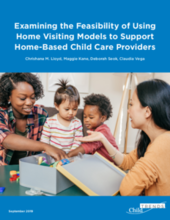Over seven million children from birth through age 5 receive child care in home-based child care (HBCC) settings, the most common form of nonparental child care in the United States. In its simplest form, HBCC is child care that is provided in a caregiver’s home by someone other than the child’s parent or primary caretaker. States and locales vary in the specific rules they set for regulation and/or licensing of these homes, including how many children a provider can care for without needing to be licensed.
Research shows that professional development can help child care providers improve the quality of care that they offer, potentially improving children’s outcomes. HBCC providers, however, often work alone and provide care outside of standard work hours, which can make it difficult for them to participate in traditional professional development trainings that happen outside of the home. These traditional trainings are also often developed for child care providers working in center-based settings and do not address the unique needs of HBCC providers. In addition, HBCC provider participation in state systems intended to support the quality of child care settings varies depending on state and local policies, as well as on outreach to support HBCC provider involvement.
To ensure that HBCC providers receive the support they need to successfully foster learning and development for children in their care, early childhood education systems and agencies must explore new professional development methods that align more closely with HBCC providers’ needs. Some state agencies and home visiting model developers have begun to explore home visiting as a professional development approach to support HBCC providers. Home visiting is a prevention strategy provided in the home to families by qualified professionals such as social workers, child development specialists, nurses, and others. While home visiting traditionally focuses on parents and their children, the in-home model of delivery and the focus on child development topics make it well suited to adaptation for HBCC providers.
To explore the potential for scaling up this model of professional development for HBCC providers, Child Trends, with funding from the Foundation for Child Development (FCD), examined home visiting models and curricula, state- and federal-level policies related to early care and education and home visiting, funding streams to support early care and education and home visiting, and the perspectives of HBCC providers and parents. The report concludes with suggestions for ways that organizations that fund research, technical assistance, and other activities to support HBCC providers can support this work.

